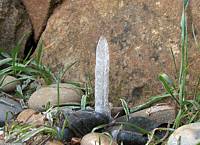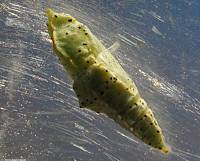|
|
Nature
Switched On
|
|
|
|
introduction |
2011 February 5 to 15
It has been a continuous sequence
of thawing and freezing up these days. No rain or snow for many
weeks, but dry winters are a characteristic of the Mediterranean
climate.
|
Some hours after the first rain shower in many weeks. |
|
|
Upper and lower pond. |
The partly frozen upper pond
with the underwater 'meadow' of a macro-alga (Chara). 5 Feb 15:21
|
||
|
The upper pond frozen up again. 7 Feb 9:56 |
|||
|
One day there occurred a curious phenomenon in the filter pond. The relatively warm drain water from the solar shower was dripping from the pond into the lower sink, forming a nice stalagmite. Usually water forms of course stalactites: the typical icicles hanging down from roof edges and caves.
|
|||
| The sink
where the water from the filter pond is dripping down. 8 Feb 9:57 |
The water stalagmite of about
6cm tall. The grass is Bromus diandrus. 8 Feb 9:59 |
||
|
In our zone we also experience the greenhouse effect. Not the global
one this time, but a local one: our solar greenhouse, where two
Cabbage butterflies
(Pieris rapae)
emerged
from their cocoons. |
|||
| This
cocoon of probably another Cabbage butterfly is stuck to the
transparent fibre roof of the greenhouse where it will warm up
easily. 10 Feb 12:41 |
Cabbage butterfly just under the
fibre roof. They will harm my cabbages but I couldn't come to kill
it. Probably some early morning frost will. 9 Feb 15:27 |
||
|
I used the beautiful quiet sunny days to assemble
another piece of Adir
|
|||
|
The assembly of the bank, showing the entrails with double layers
of legs and seating to make up for the poor quality of the wood. 8 Feb 10:03
The bank after staining. |
To make the chair more comfortable and compensate for the high
arms, I made some cushions from canvas (of the old caravan) filled
up with, you'll guess it, straw. |
||
|
Left-overs of the pallets were used for a decent door and roof for the washing machine cabinet. The roof was partly furnished with salvaged flat bricks and the remainder filled up with soil and Sedum and Sempervivum cuttings.
Being the fourth or fifth area being planted with these species, one
can imagine my fascination with these diehards of the plant kingdom.
|
|||
|
The cabinet for the washing machine with an improvised green
roof. 11 Feb 15:49 |
|||
|
Five roofs of which four are planted with members of the
stonecrop family. |
The green roof with cuttings of
Sedum anglicum, S. acre, S. sediforme, S. reflexum, S. album, S.
dasyphyllum and Sempervivum tectorum. 11 Feb 15:48 |
||
|
The washing machine is performing well, but we had a strange
experience. It usually consumes around 700W (without heating the
water) and that is almost the maximum power supply of the batteries
(750W) but one day we |
|||
|
The batteries of the solar panel
system can hold on for two or three overcast days and then one
morning of sunlight is sufficient to restore them completely. 14 Feb 13:05 |
|||
|
introduction
|
|














